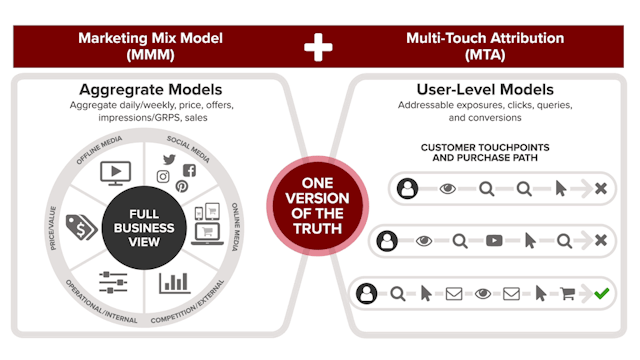Combined forces: when attribution falls short, take a unified view
For many years, Multi-touch Attribution (MTA) has been held up as a magic bullet that will solve many challenges for marketers and show them the true worth of their efforts and be able to optimise in real time. But the truth is MTA on its own has been a source of disappointment.

How unified measurement creates one strong version of the truth
While MTA may be a powerful method for understanding the digital touch points that influence customers, it is not enough on its own to answer the demanding questions marketers face – especially in the age of privacy legislation and increasing difficulty accessing user level data. While granular, MTA only provides a partial view of marketing efficiency without accounting for factors like offline activities, baseline sales and external factors. That’s where Unified Measurement comes in.
A complete view of your marketing
Unified Measurement leverages Marketing Mix Modelling (MMM) and MTA to bring together aggregate full-business models, and user-level models for a customer view. The result is a holistic view with consistent data and incrementality for both strategic and tactical decisions, delivering a single version of the truth.
This allows for the optimisation of cross-channel spend allocation in addition to in-depth recommendations within each channel and the ability to create a detailed customer-angle view.
The approach enables the marketer to identify and adapt to performance drivers, from marketplace changes to channel optimisation. Unified Measurement can also add nuance by offering a clearer picture of how multiple factors interact and remove the biases inherent with siloed approaches or even between departments.
Implementing unified measurement
Let’s take a closer look at a real case to understand how Unified Measurement can overcome limited visibility into incrementality and efficacy of digital efforts.
For example, a financial service provider had been increasing online media investment as digital grew in importance, but it lacked clear view into the impact of digital media and offline channels. To understand the customers better and improve results, the client sought to quantify the impact of digital across sales channels and optimise digital activity beyond last click. As a first step, the existing Marketing Mix Models were evolved for single products into aggregate models for a full business and performance view.
MTA models were then integrated to make smarter channel spend decisions. Consumers often take a cross-channel journey while making their buying decision, in finance as well as in any other high-consideration industry. They explore numerous options between providers and offers, using one or more smart phones, tablets, and desktops. This means multi-touch attribution across devices will yield important information to marketers.

Together, both models uncovered one version of the truth to help the company better understand what drives marketing performance and conversions. Throughout those measurement projects, important, actionable insights were uncovered, including that:
- Digital has a strong impact across channels. Reported digital ROI was significantly higher when capturing impacts on offline channels.
- Online applications and conversions were driven by both offline and online factors.
- TV had both an indirect and direct impact on applications across channels.
To marketing and beyond
The Unified Measurement results could then be used to forecast offline and online development. Media plans were rethought to generate more synergy across all channels. With the adaptive framework that leverages the unified measurement already in place, they could even build new models each year in line with changing business priorities and strategic focus, and regularly adjust campaigns and tactics in the company’s future.
And results were not limited to the client’s marketing team: they used advanced marketing measurement to respond to scrutiny from the finance and executive teams on its impact on the bottom line. In the process, it gained deeper insight into how effective marketing tactics differ by product line, and it developed a business case to justify bigger marketing budgets.
One version of the truth
The reality is if relying on MTA on its own, you face using biased insights and will lack the full nuance of a unified approach. In a competitive market, businesses that don’t adopt cannot afford to not have a complete picture of all the drivers of business results and understand how they interact. This knowledge can drive a true competitive advantage.

